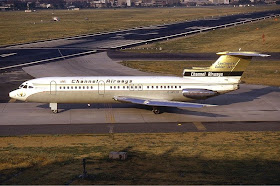Back in the mid seventies I remember on nice hot sunny days getting
on my bike and riding from my home in Windsor to the bottom of Heathrow’s 10L.
I would take a packed lunch and sit for hours on the grass and watch aircraft
zooming over my head as they touched down. When I smell the fuel now at work it
always takes me back to those magic days at the end of the runway or watching aircraft
from the top of the Queens Building at the heart of Heathrow.
 |
| ...and another ZZzzzz |
Along with the wonderful smoky and noisy Caravelles, DC-8s, Viscounts etc (I could go on and on) I got so bored of seeing endless British Airways Tridents. I confess now in the days of all look-a-like jets, how I would love to see a Trident in the air again! Looking back now I think it is time to remember this odd 3 engine beast (or 4 as in the case of the Trident 3Bs). Many pictures are about of BEA/BA’s Tridents so here are most of the others...
 |
| Nice colours and photo of Air Ceylon's Trident 1E 4R-ACN (cn 2135) See below... |
 |
| Trident 1E 4R-ACN (cn 2135) Air Lanka after country & airline name change. I don't think this aircraft ever flew in the new colours? |
 |
| A great landing shot of Trident 2E B-2210 (cn 2178) CAAC |
 |
| Trident 1E G-AVYC (cn 2137) of BKS Air Transport See below... |
 |
| Another of Trident 1E G-AVYC (cn 2137) this time in Northeast Colours |
 |
| Chinese Air Force Trident 1E 50051 (cn 2130) |
 |
| Trident 1E YI-AEA (cn 2125) Iraqi Airways |
 |
| Trident 1E G-AVYB (cn 2136) Channel Airways |
 |
| Trident 1E 9K-ACH (cn 2134) Kuwait Airways |
 |
| Trident 1E AP-AUG (cn 2133) PIA See below... |
 |
| Another of Trident 1E AP-AUG (cn 2133) in Pakistan Air Force Colours |
 |
| Trident 3B 9Q-CTM (cn 2304) Air Charters Zaire |
 |
| HS-121 Trident 3B G-AWKZ (cn 2312) It was painted by BA Engineering in BA's Landor colours but never flew like this. Very smart! See Below... |
 |
| Trident 3B G-AWKZ (cn 2312) as she looks in 2013 at Manchester Airport in BEA colours. Not bored with Tridents now! Photo by The Aviation Anorak |
http://www.hs121.org/
http://en.wikipedia.org/wiki/Hawker_Siddeley_Trident
Chinese Air Force Trident 50051:
http://www.aviationmuseum.eu/World/Asia/China/Beijing/China_Aviation_Museum.htm
BEA Trident 3B G-AWKZ :
http://www.manchesterairport.co.uk/manweb.nsf/content/runwayvisitorpark

